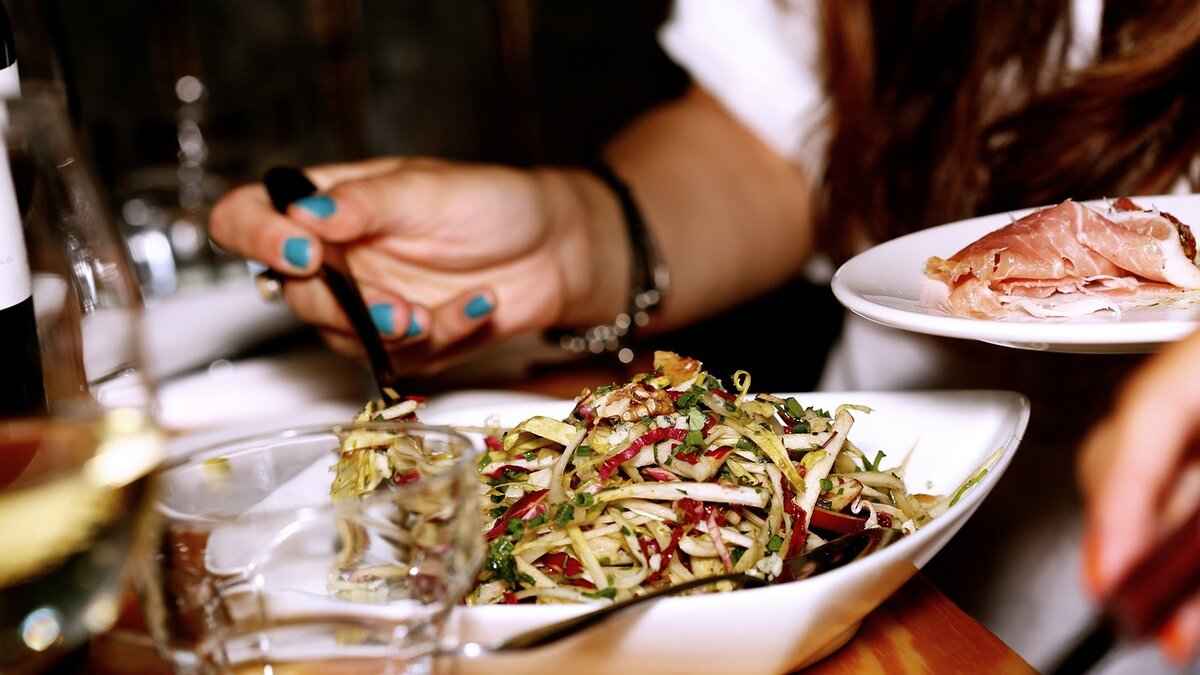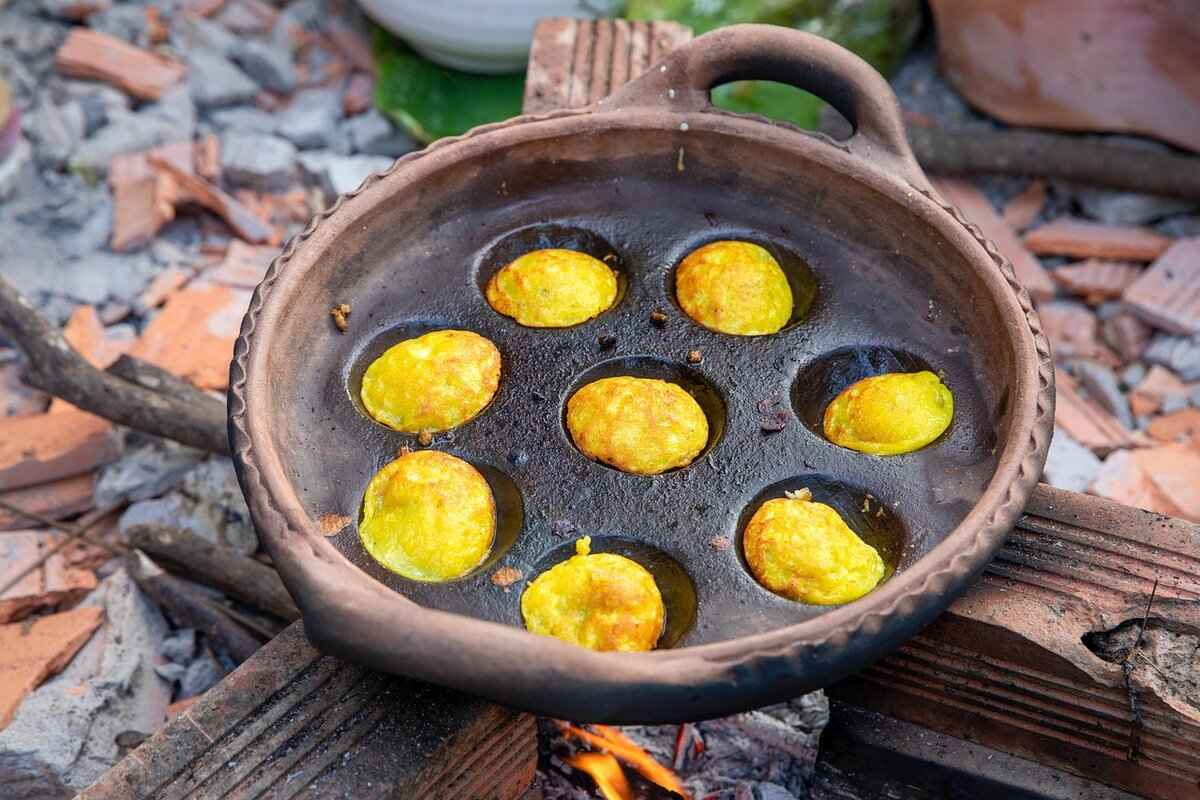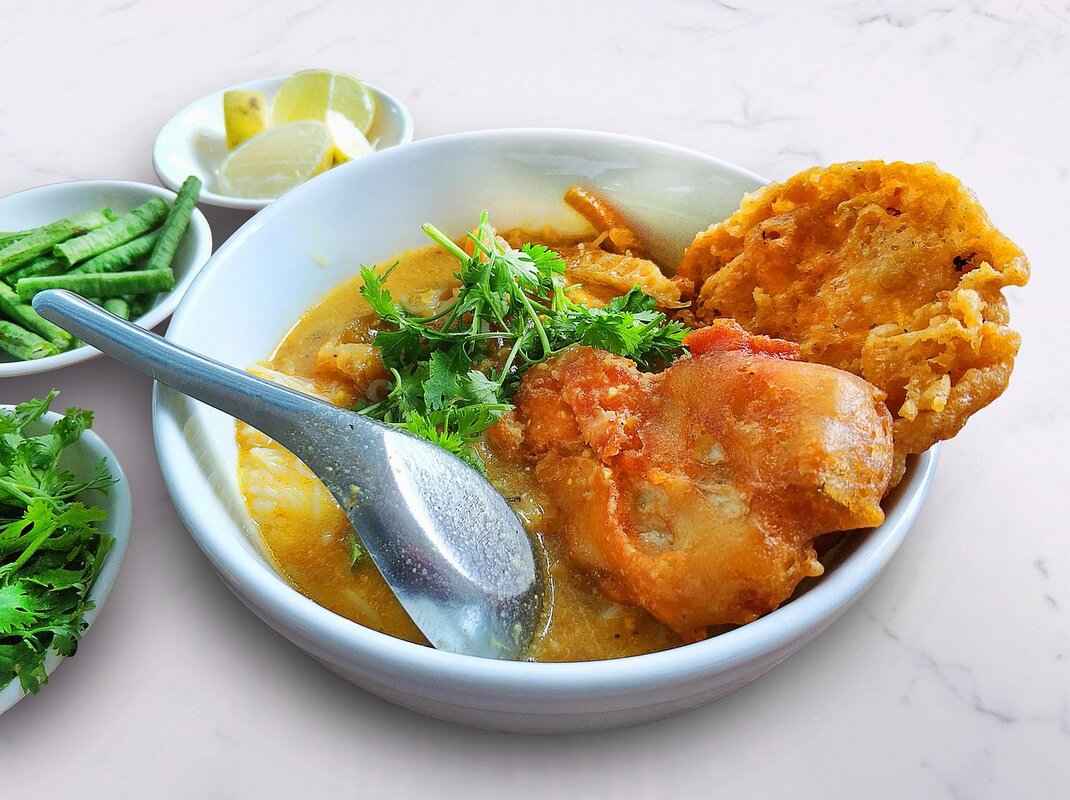Embark on a culinary journey through Burmese cuisine, a vibrant tapestry of flavors that reflects the rich history and cultural diversity of Myanmar. This unique cuisine is shaped by various ethnic groups and their traditions, making it a treasure trove of regional specialties and hidden gems. Whether you are a seasoned food enthusiast or a curious traveler, exploring the depths of Burmese food promises an unforgettable experience.
Burmese cuisine is a fascinating fusion of flavors influenced by neighboring countries such as India, Thailand, and China. This blend results in a variety of dishes that balance sweet, sour, salty, and spicy elements. The use of fresh herbs, spices, and local ingredients is central to creating the distinct tastes that define this culinary tradition.
Key ingredients form the backbone of Burmese dishes. Familiarizing yourself with these staples will help you appreciate the complexity and depth of flavors in Burmese food. Common ingredients include:
- Rice: The staple food of Myanmar, served with almost every meal.
- Fish Sauce: Adds a salty umami flavor to many dishes.
- Chickpea Flour: Often used in snacks and street food.
- Fermented Tea Leaves: The star ingredient in the famous tea leaf salad.
From savory curries to tangy salads, Myanmar boasts a variety of must-try dishes that represent the essence of Burmese cuisine. Here are a few iconic foods:
- Mohinga: Considered the national dish, this fish-based soup is a breakfast staple, rich in flavor and comfort.
- Tea Leaf Salad (Lahpet): A unique delicacy made with fermented tea leaves, nuts, and spices that showcases the innovative use of tea.
- Shan Noodles: A popular dish from Shan State, featuring rice noodles served with a savory broth and garnished with fresh herbs.
Myanmar’s diverse regions each offer distinct culinary traditions. Exploring these regional variations reveals the country’s rich cultural tapestry and local ingredients. For example:
- Shan State Dishes: Known for rice dishes and flavorful curries, these meals often feature fresh herbs and spices.
- Rakhine Cuisine: Influenced by coastal living, Rakhine dishes emphasize seafood and rice, showcasing unique flavors.
Street food is an integral part of Burmese culture, offering an array of affordable and delicious options. Popular items include:
- Grilled Skewers: A favorite among locals, these skewers are marinated and grilled to perfection.
- Savory Pancakes: Often filled with vegetables or meat, these pancakes are a quick and tasty snack.
Many ingredients used in Burmese cooking offer significant health benefits. For instance, herbs and spices like turmeric and ginger are not only flavorful but also have anti-inflammatory properties. Additionally, the emphasis on vegetable-centric dishes promotes a healthy diet, making Burmese cuisine a delightful and nutritious choice.
If you’re not in Myanmar, experiencing authentic Burmese cuisine abroad is still possible. Look for restaurants that specialize in Burmese dishes, and consider participating in cooking classes to deepen your understanding of this rich culinary tradition. Engaging with the local Burmese community can also enhance your culinary exploration, providing insights into traditional recipes and cooking techniques.

What Makes Burmese Cuisine Unique?
Burmese cuisine is a captivating culinary journey that reflects the rich cultural heritage of Myanmar. With its diverse ethnic groups and geographical influences, the cuisine offers a unique blend of flavors, textures, and aromas that set it apart from other Southeast Asian foods. Understanding what makes this cuisine distinct can significantly enhance your dining experience and appreciation for its intricate dishes.
The uniqueness of Burmese cuisine lies in its fusion of flavors and the use of fresh ingredients. Influenced by neighboring countries such as India, China, and Thailand, Burmese food showcases a variety of cooking techniques and flavor profiles. Here are some key aspects that contribute to its uniqueness:
- Diverse Ingredients: Burmese dishes often include a wide array of ingredients such as rice, legumes, fish, and vegetables. Key staples like fermented tea leaves and tamarind add distinctive flavors that are not commonly found in other cuisines.
- Regional Variations: Different regions of Myanmar have their own culinary traditions. For instance, the coastal areas focus on seafood, while the mountainous regions emphasize rice and hearty stews. This regional diversity enhances the overall richness of Burmese cuisine.
- Balance of Flavors: Burmese cooking is characterized by a harmonious balance of sweet, sour, salty, and spicy flavors. Dishes often incorporate ingredients that provide contrasting tastes, creating a delightful sensory experience.
- Use of Fresh Herbs and Spices: Fresh herbs like coriander and basil are commonly used in Burmese cooking, enhancing the freshness and vibrancy of dishes. Spices such as turmeric and ginger not only add flavor but also offer health benefits.
- Community and Sharing: Meals in Myanmar are often communal, emphasizing the importance of sharing food with family and friends. This cultural practice fosters a sense of togetherness and enhances the overall dining experience.
To truly appreciate Burmese cuisine, one must explore its traditional cooking methods. For example, many dishes are prepared using slow-cooking techniques that allow flavors to meld and develop over time. This patience in preparation is a testament to the respect for food in Burmese culture.
Another fascinating aspect is the role of street food in Myanmar. Street vendors offer an array of affordable and delicious options, from savory snacks to hearty meals. Trying these dishes provides an authentic taste of local life and culinary creativity.
In summary, the uniqueness of Burmese cuisine is a result of its diverse ingredients, regional variations, and the cultural significance of food in Myanmar. Understanding these elements not only enhances your culinary experience but also deepens your appreciation for the rich tapestry of flavors that define this remarkable cuisine.

Essential Ingredients in Burmese Cooking
Burmese cuisine is a treasure trove of flavors, textures, and aromas, deeply rooted in the rich cultural heritage of Myanmar. At the heart of this culinary tradition are the essential ingredients that form the backbone of its dishes. Understanding these key components is crucial for anyone looking to appreciate the complexity and depth of flavors that Burmese food has to offer.
The primary ingredients in Burmese cooking are a blend of local produce, spices, and unique flavor enhancers. Familiarizing yourself with these staples can significantly elevate your culinary experience.
- Rice: A staple food in Myanmar, rice is often the foundation of a meal. Varieties such as Shan rice and sticky rice are commonly used.
- Fish Sauce: This fermented condiment is essential for adding umami and depth to many dishes, enhancing flavors in soups and salads.
- Chili Peppers: Fresh or dried, chili peppers are integral to Burmese cuisine, providing the necessary heat and vibrant color.
- Turmeric: Known for its health benefits, turmeric adds a warm color and earthy flavor to curries and rice dishes.
- Fermented Tea Leaves: Used in the famous tea leaf salad, these leaves contribute a unique taste and are a symbol of Burmese culinary innovation.
- Peanuts: Often used in salads and as a garnish, peanuts add crunch and richness to various dishes.
- Fresh Herbs: Ingredients like coriander and mint are frequently used to brighten dishes and add freshness.
The combination of these ingredients creates a symphony of flavors that is distinctly Burmese. For instance, the use of fish sauce and fermented tea leaves provides a unique umami experience, while the spices and herbs balance the dishes with their aromatic qualities. Understanding the role of these ingredients can help you appreciate the intricate layering of flavors in Burmese cooking.
Indeed, Myanmar’s diverse geography and ethnic groups contribute to regional variations in ingredients. For example:
- Shan State: Known for its rice dishes, this region often incorporates local vegetables and herbs that are unique to the area.
- Rakhine State: Coastal influences mean that seafood is a prominent ingredient, with dishes often featuring fresh fish and shrimp.
Bringing the flavors of Burmese cuisine into your kitchen is easier than you might think. Start by sourcing key ingredients from local Asian markets or online stores. Experimenting with rice dishes or creating a simple tea leaf salad can be a great introduction to this vibrant cuisine.
Additionally, consider taking a cooking class focused on Burmese cuisine. This hands-on experience can deepen your understanding of how to use these essential ingredients effectively.
In summary, the essential ingredients of Burmese cooking are not just components of a dish; they are the essence of a rich culinary tradition. By exploring these ingredients, you will gain a greater appreciation for the complexity and depth of flavors that define Burmese cuisine.

Must-Try Dishes from Myanmar
Burmese cuisine is a treasure trove of flavors and textures, showcasing the rich cultural heritage of Myanmar. With a wide array of dishes that reflect the country’s diverse ethnic groups and regional ingredients, there are numerous culinary delights that every food lover should experience. In this section, we will delve into some of the most iconic dishes that represent the essence of Burmese cuisine.
- Mohinga: Often hailed as the national dish of Myanmar, Mohinga is a fragrant fish soup made with rice noodles, lemongrass, and a blend of spices. Traditionally enjoyed for breakfast, this dish is a comforting start to the day, embodying the warmth of Burmese hospitality.
- Tea Leaf Salad (Lahpet): This unique delicacy features fermented tea leaves tossed with nuts, peas, and a medley of spices. The combination of flavors and textures makes Lahpet a must-try dish that showcases the innovative use of tea in Burmese cuisine.
- Shan Noodles: Originating from the Shan State, this dish includes flat rice noodles served with a savory broth, topped with marinated chicken or pork, and garnished with fresh herbs. The simplicity and depth of flavor make it a favorite among locals and visitors alike.
- Rakhine Fish Curry: Hailing from the coastal region of Rakhine, this dish is characterized by its rich, spicy fish curry made with fresh seafood and aromatic spices. The use of local ingredients highlights the region’s maritime heritage.
- Grilled Skewers (Sate): Street vendors across Myanmar serve delicious grilled skewers made from marinated meat, often accompanied by a spicy dipping sauce. These savory bites are perfect for a quick snack while exploring the vibrant streets.
- Onnokauswe: A traditional noodle dish from the Shan State, Onnokauswe features thick rice noodles served with a creamy coconut milk broth, chicken, and a sprinkle of fresh herbs. This dish is a hearty option that reflects the region’s culinary traditions.
Each of these dishes tells a story about the people and traditions of Myanmar. For instance, Mohinga is more than just a meal; it is a symbol of community and family gatherings. Similarly, Tea Leaf Salad serves as a reminder of the innovative spirit of the Burmese people, who have transformed a simple ingredient into a celebrated dish. These culinary treasures are not only delicious but also serve as a window into the rich cultural tapestry of Myanmar.
For those eager to experience the flavors of Myanmar, visiting local restaurants or street food stalls is an excellent way to start. Many establishments offer authentic versions of these dishes, allowing you to savor the true essence of Burmese cuisine. Additionally, participating in cooking classes can provide valuable insights into the preparation and significance of these iconic dishes, enriching your culinary journey.
In conclusion, the must-try dishes of Myanmar offer a glimpse into the heart of Burmese culture. From the comforting warmth of Mohinga to the innovative flavors of Lahpet, each dish is a celebration of the country’s rich culinary heritage. Embrace the opportunity to explore these flavors and enjoy the vibrant food scene that Myanmar has to offer.
Mohinga: The National Dish
Mohinga, a beloved fish-based soup, is often celebrated as the national dish of Myanmar. This iconic dish is not just a meal; it embodies the heart and soul of Burmese culinary traditions. With its rich flavors and comforting texture, Mohinga has become a staple breakfast choice for many, enjoyed by locals and visitors alike.
Typically made with catfish or other freshwater fish, Mohinga features a broth that is delicately flavored with lemongrass, ginger, and garlic. The soup is often enriched with rice noodles, which absorb the fragrant broth, creating a satisfying meal. A sprinkle of fried onions and a squeeze of lime before serving adds a delightful crunch and acidity, enhancing the overall experience.
The popularity of Mohinga can be attributed to several factors. Firstly, it is versatile—enjoyed for breakfast, lunch, or dinner. Secondly, the dish is affordable and widely available, found in street stalls and restaurants across Myanmar. Its ability to cater to different tastes, with variations in ingredients and spice levels, makes it appealing to a broad audience.
- Fish: Typically catfish or tilapia.
- Noodles: Rice vermicelli is commonly used.
- Broth: Made from fish stock, seasoned with spices.
- Herbs: Lemongrass, ginger, and garlic are essential.
- Toppings: Fried onions, boiled eggs, and cilantro enhance flavor.
Mohinga is traditionally served hot, often accompanied by side dishes such as crispy fritters or pickled vegetables. The dish is typically enjoyed with a side of chili paste for those who prefer a spicier kick. This communal aspect of sharing and enjoying food together adds to the warmth of the dining experience.
While Mohinga is a national dish, it also showcases regional variations. In the Irrawaddy Delta, for example, the soup might be thicker and richer, while in Yangon, vendors may add unique ingredients like coriander or banana stems. Each region’s take on Mohinga reflects local tastes and available ingredients, making it a dish that evolves while retaining its core identity.
Mohinga is not only delicious but also offers several health benefits. The fish provides a good source of protein and omega-3 fatty acids, essential for heart health. The herbs and spices used in the broth, such as ginger and garlic, are known for their anti-inflammatory properties. Additionally, the inclusion of fresh vegetables and herbs contributes to a well-balanced meal.
In conclusion, Mohinga is more than just a dish; it is a symbol of Myanmar’s rich culinary heritage. Whether enjoyed at a bustling street stall or made at home, this fish-based soup continues to warm the hearts of those who indulge in its comforting embrace.
Tea Leaf Salad: A Unique Delicacy
Tea leaf salad, known locally as Lahpet, is a remarkable dish that stands out in the diverse landscape of Burmese cuisine. This unique salad is not just a meal; it is a cultural symbol that showcases the innovative ways in which tea is utilized in Myanmar’s culinary traditions. But what exactly makes Lahpet a must-try delicacy?
The primary ingredient in Lahpet is fermented tea leaves, which are transformed into a tangy and flavorful base. These leaves are often mixed with a variety of ingredients to create a delightful medley of textures and flavors. The typical components include:
- Nuts: Roasted peanuts or sesame seeds add a crunchy texture.
- Peas: Split peas or chickpeas contribute to the dish’s heartiness.
- Spices: Various spices, including garlic and chili, enhance the overall flavor profile.
- Vegetables: Fresh ingredients like tomatoes, cabbage, or lime are often included for added freshness.
The popularity of Lahpet can be attributed to its unique flavor and its role in social gatherings. It is often served as a snack or appetizer during celebrations and family gatherings, symbolizing hospitality and community. The dish is not only delicious but also represents the rich cultural heritage of Myanmar, where tea is more than just a beverage; it is a way of life.
Beyond its delightful taste, Lahpet offers several health benefits. Fermented tea leaves are rich in antioxidants and are believed to aid in digestion. The inclusion of nuts and peas adds protein and healthy fats, making this salad a nutritious choice. Additionally, the use of fresh vegetables contributes essential vitamins and minerals, promoting a balanced diet.
When it comes to enjoying Lahpet, there are a few key points to consider:
- Pairing: Lahpet can be enjoyed on its own or paired with rice and curries for a complete meal.
- Serving Style: It is often served in a communal dish, allowing everyone to share and enjoy together.
- Customization: Feel free to customize the ingredients based on personal preferences or dietary needs.
If you’re eager to try Lahpet, look for local Burmese restaurants or food stalls that offer authentic dishes. Many places will prepare the salad fresh to order, ensuring you experience the full range of flavors. Additionally, some restaurants may offer variations of Lahpet, incorporating local ingredients that reflect regional tastes.
Absolutely! Making Lahpet at home can be a rewarding experience. Here’s a simple recipe to get you started:
Ingredients:- 1 cup fermented tea leaves- 1/2 cup roasted peanuts- 1/2 cup split peas- 1 small tomato, diced- 1/2 cup shredded cabbage- 1-2 cloves of garlic, minced- Chili flakes to taste- Lime juice to tasteInstructions:1. In a bowl, combine the fermented tea leaves, roasted peanuts, and split peas.2. Add the diced tomato, shredded cabbage, minced garlic, and chili flakes.3. Drizzle with lime juice and mix well.4. Serve immediately and enjoy!
In summary, Tea leaf salad is a distinctive and flavorful representation of Burmese cuisine. Its unique combination of ingredients, health benefits, and cultural significance make it a dish worth exploring. Whether enjoyed in Myanmar or made at home, Lahpet is sure to delight the palate and provide a taste of this rich culinary tradition.

Regional Variations in Burmese Cuisine
Burmese cuisine is a delightful mosaic of flavors, textures, and aromas, deeply influenced by the country’s diverse ethnic groups and geographical regions. Each area of Myanmar boasts its own culinary traditions, showcasing unique ingredients and cooking methods that reflect the local culture and environment. In this exploration of , we will delve into the distinctive characteristics that make each region’s food a treasure trove for culinary enthusiasts.
Myanmar is divided into several regions, each with its own culinary identity. Understanding these regional styles can significantly enhance your appreciation of Burmese food.
- Central Myanmar: This region is known for its hearty dishes, with rice as the staple. The use of pork and chicken in curries is prevalent, often accompanied by pickled vegetables and fermented sauces.
- Shan State: Renowned for its rice dishes and flavorful curries, Shan cuisine emphasizes the use of fresh herbs and spices, making it a must-try for food lovers.
- Rakhine State: With its coastal geography, Rakhine cuisine is heavily influenced by seafood. Dishes often feature fish and prawns, seasoned with local spices that create a unique flavor profile.
- Kachin State: Known for its rich and spicy dishes, Kachin cuisine incorporates a variety of wild herbs and ingredients, reflecting the region’s mountainous terrain.
The diversity of local ingredients plays a crucial role in shaping the culinary landscape of Myanmar. Each region utilizes what is readily available, leading to distinct flavors in their dishes.
- Rice: The foundation of most meals, rice varieties differ across regions, with Shan rice being particularly famous for its aroma.
- Herbs and Spices: Ingredients like turmeric, ginger, and lemongrass are staples that enhance the flavor of dishes, providing depth and complexity.
- Vegetables: Each region boasts a variety of locally grown vegetables, such as pumpkin in the Central region and watercress in Shan State, contributing to the freshness of the cuisine.
Exploring the iconic dishes from each region offers a glimpse into the heart of Burmese cuisine. Here are some must-try dishes that represent the essence of regional flavors:
- Mohinga: Often regarded as the national dish, this fish soup is a breakfast favorite, rich in flavor and served with rice noodles.
- Shan Noodles: A signature dish from Shan State, these rice noodles are served with a savory broth, often topped with chicken or pork and fresh herbs.
- Rakhine Fish Curry: This dish features fresh fish cooked in a spicy coconut sauce, showcasing the coastal influences of Rakhine cuisine.
- Kachin Curry: Known for its heat, this curry is made with various meats and wild herbs, reflecting the Kachin people’s connection to their natural surroundings.
In conclusion, the regional variations in Burmese cuisine not only highlight the diversity of flavors but also tell the story of Myanmar’s rich cultural heritage. Each dish is a reflection of the land, the people, and their traditions, making Burmese food a truly unique culinary adventure.
Shan State Dishes
Shan State, located in the eastern part of Myanmar, is renowned for its rich culinary heritage, particularly its rice dishes and vibrant curries. The region’s cuisine is a reflection of its diverse ethnic groups, each contributing unique flavors and cooking techniques. In this section, we will delve deeper into what makes Shan State dishes truly exceptional.
Shan State cuisine is characterized by its use of fresh herbs and spices, which elevate the flavors of the dishes. The emphasis on using local ingredients, such as rice, vegetables, and meats, creates a distinctive taste that is both comforting and satisfying. The cooking methods often involve steaming, boiling, and stir-frying, preserving the natural flavors of the ingredients.
Rice is not just a staple food in Shan State; it is a cultural symbol. The region is famous for its variety of rice dishes, including:
- Shan Rice: A fragrant rice dish often served with curries or salads.
- Rice Noodles: Thin rice noodles are commonly used in soups and salads, providing a light yet filling meal.
- Sticky Rice: A popular choice for both savory and sweet dishes, sticky rice is often paired with side dishes or enjoyed on its own.
The curries of Shan State are known for their rich flavors and aromatic spices. Some notable examples include:
- Shan Chicken Curry: A flavorful dish made with tender chicken, turmeric, and fresh herbs, often served with rice.
- Pork Curry: This dish features succulent pieces of pork cooked in a spicy sauce, offering a delightful balance of heat and flavor.
- Vegetable Curry: A medley of seasonal vegetables cooked in a light curry sauce, showcasing the region’s agricultural bounty.
Fresh herbs are integral to Shan State cooking, providing not only flavor but also health benefits. Commonly used herbs include:
- Basil: Adds a sweet and aromatic flavor to dishes.
- Cilantro: Known for its fresh and zesty taste, it enhances the overall flavor profile of curries and salads.
- Mint: Often used in salads, mint adds a refreshing touch to meals.
Local ingredients are the backbone of Shan State dishes. The region’s fertile land allows for the cultivation of various vegetables, herbs, and rice varieties. This farm-to-table approach not only supports local farmers but also ensures that the dishes are fresh and flavorful. Additionally, the use of traditional cooking methods helps to preserve the integrity of the ingredients.
If you find yourself in Shan State, make sure to explore local markets and street food stalls, where you can sample authentic dishes. Participating in cooking classes can also provide valuable insights into the region’s culinary techniques and ingredients. For those outside Myanmar, seek out authentic Burmese restaurants that offer Shan specialties to get a taste of this unique cuisine.
In conclusion, Shan State dishes are a celebration of flavor, freshness, and cultural heritage. The combination of rice, vibrant curries, and fresh herbs creates a culinary experience that is not to be missed. Whether you are in Myanmar or exploring Burmese cuisine abroad, indulging in Shan State dishes is a delightful journey for any food enthusiast.
Rakhine Cuisine: Coastal Influences
Rakhine cuisine stands out as a vibrant representation of Myanmar’s coastal culinary heritage. Nestled along the western shores of the country, Rakhine State is blessed with abundant marine resources, which significantly influence its traditional dishes. This cuisine is characterized by its emphasis on seafood and rice, reflecting the daily lives of the local people who rely on the sea for sustenance.
Rakhine cuisine is marked by its use of fresh, local ingredients that create unique flavors. The proximity to the ocean means that seafood, particularly fish and shellfish, plays a central role in many dishes. Additionally, the region’s rice cultivation contributes to a variety of rice-based meals that showcase local cooking techniques.
Seafood dishes in Rakhine cuisine are often prepared with minimal seasoning to allow the natural flavors of the fish to shine through. Common methods of preparation include grilling, steaming, and frying. Some popular seafood dishes include:
- Ngapi Yay: A fermented fish paste that serves as a condiment, enhancing the flavor of various dishes.
- Fish Curry: Typically made with freshly caught fish simmered in a rich, spicy sauce.
- Grilled Prawns: Marinated in local spices and grilled to perfection, often served with a side of rice.
Rice is a staple in Rakhine cuisine, often served as the main component of meals. The region is known for its aromatic rice varieties, which are often paired with seafood or vegetable dishes. Notable rice dishes include:
- Rakhine Rice: A flavorful rice dish cooked with turmeric, giving it a distinct yellow hue.
- Rice with Fish: A simple yet delicious combination that highlights the freshness of local ingredients.
Rakhine cuisine utilizes a variety of herbs and spices that contribute to its bold flavors. Common ingredients include:
- Ginger: Adds warmth and depth to many dishes.
- Garlic: Used generously for its aromatic qualities.
- Chili: Provides heat, balancing the richness of seafood.
The culinary traditions of Rakhine reflect the culture and lifestyle of its people. Meals are often communal, emphasizing the importance of sharing and togetherness. Festivals and celebrations frequently feature traditional Rakhine dishes, showcasing the region’s rich heritage.
For those interested in exploring Rakhine cuisine, visiting local markets and street food stalls is highly recommended. Here, you can find fresh seafood and traditional dishes prepared by local vendors. Additionally, many restaurants in Rakhine State offer a diverse menu that highlights the region’s culinary specialties.
In conclusion, Rakhine cuisine is a delightful exploration of coastal flavors and ingredients. The emphasis on seafood and rice, combined with the use of local herbs and spices, creates a unique culinary experience that is integral to Myanmar’s cultural identity.

The Role of Street Food in Myanmar
Street food in Myanmar is not just a meal; it is a vibrant part of the country’s cultural identity. Offering an array of affordable and delicious options, it reflects the daily lives of the people and their culinary traditions. For anyone interested in exploring Myanmar’s rich tapestry of flavors, understanding the street food scene is essential.
The popularity of street food in Myanmar can be attributed to several factors:
- Affordability: Street food provides a budget-friendly option for locals and travelers alike. Dishes are typically priced between 500 to 2,000 kyats (approximately $0.30 to $1.50), making it accessible to everyone.
- Variety: From savory snacks to hearty meals, the variety of street food reflects the diverse culinary influences in Myanmar, including Indian, Chinese, and Thai flavors.
- Social Experience: Street food stalls are often bustling hubs of activity, where people gather to eat, chat, and share stories. This makes dining a communal experience.
When exploring the streets of Myanmar, be sure to sample these popular street food items:
- Grilled Skewers: Known locally as satay, these skewers of marinated meat, often served with a spicy dipping sauce, are a must-try.
- Tea Leaf Salad: This unique dish combines fermented tea leaves with nuts, peas, and various spices, offering a delightful mix of flavors and textures.
- Shan Noodles: Originating from the Shan State, these rice noodles are served with a flavorful broth and topped with meat or vegetables.
- Fried Snacks: From fried tofu to spring rolls, these crispy delights are perfect for on-the-go snacking.
Understanding the etiquette surrounding street food can enhance your experience:
- Ordering: Approach the stall, look at the offerings, and point to what you want. Most vendors are friendly and will help you with your selection.
- Payment: Cash is king in street food markets. Have small bills ready to speed up the transaction.
- Eating: It’s common to eat standing up or at small tables nearby. Don’t be shy—join the locals in enjoying your meal!
While street food is delicious, it’s essential to consider health and safety:
- Freshness: Choose stalls that are busy, as high customer turnover usually indicates fresh ingredients.
- Hygiene: Look for vendors who maintain a clean cooking area and use gloves or utensils for serving food.
Experiencing street food in Myanmar is an adventure that offers a taste of the country’s rich culinary heritage. By trying local dishes and understanding the culture surrounding them, you can immerse yourself in the authentic flavors of Myanmar. Whether you’re a seasoned traveler or a curious foodie, the street food scene is a vital part of your culinary exploration.
Popular Street Food Items
Street food in Myanmar is not just a meal; it’s a cultural experience that reflects the country’s rich heritage and vibrant daily life. From bustling markets to roadside stalls, the aroma of grilled meats and spicy snacks fills the air, inviting locals and tourists alike to indulge in these delicious offerings. Here, we explore some of the most popular street food items that you simply cannot miss when visiting Myanmar.
- Grilled Skewers (Sate): One of the most beloved street foods, these skewers are typically made with marinated meat, such as chicken or pork, grilled to perfection. Served with a side of spicy dipping sauce, they are a favorite among locals.
- Savory Pancakes (Burmese Kya Zan): These thin, crispy pancakes are often filled with a variety of ingredients, including vegetables and meat. They are perfect for a quick snack on the go.
- Mohinga: Often regarded as the national dish, this fish soup is served with rice noodles and garnished with crispy fritters. It’s a breakfast staple that offers a warm and comforting start to the day.
- Tea Leaf Salad (Lahpet): A unique dish made from fermented tea leaves, mixed with nuts, peas, and spices. This salad is not only flavorful but also rich in cultural significance.
- Fried Tofu (Tofu Nway): Crispy on the outside and soft on the inside, this dish is often served with a tangy sauce and is a popular vegetarian option.
Sampling street food in Myanmar is essential for immersing yourself in the local culture. These dishes are often prepared with recipes passed down through generations, showcasing the culinary traditions of various ethnic groups. By trying street food, you not only satisfy your taste buds but also gain insight into the daily lives of the Burmese people.
While indulging in street food, it’s important to keep a few safety tips in mind:
- Choose Busy Stalls: Opt for stalls that are popular with locals, as high turnover usually means fresher ingredients.
- Observe Hygiene Practices: Look for vendors who maintain cleanliness in their food preparation areas.
- Drink Bottled Water: To avoid any stomach issues, it’s advisable to drink bottled water instead of tap water.
Myanmar’s diverse regions contribute to a variety of street food offerings. For example, in Yangon, you’ll find a plethora of noodle dishes, while Mandalay is famous for its rich curries and rice dishes. Each region boasts its own specialties, reflecting the local ingredients and culinary influences.
Exploring the street food scene in Myanmar is an adventure that tantalizes the senses. From the tantalizing aroma of grilled skewers to the unique flavors of tea leaf salad, each dish tells a story of the country’s rich culinary heritage. So, when you find yourself in Myanmar, don’t miss out on the opportunity to sample these delicious street foods for a truly authentic experience.
Street Food Etiquette
When it comes to experiencing the vibrant street food culture of Myanmar, understanding is essential. This knowledge not only enhances your culinary adventure but also fosters a respectful interaction with local vendors. Here, we delve into the key aspects of navigating street food stalls in Myanmar.
Street food is more than just a meal; it is a reflection of Myanmar’s rich culture and traditions. Adhering to proper etiquette can lead to a more enjoyable experience and helps build rapport with the vendors, who are often eager to share their culinary expertise.
- Observe First: Before diving in, take a moment to observe the stall. Look at how others are ordering and interacting with the vendor.
- Be Polite: Greet the vendor with a smile and a simple “Mingalaba” (Hello). Politeness goes a long way in establishing a friendly atmosphere.
- Know What You Want: Familiarize yourself with the menu items. If you’re unsure, don’t hesitate to ask for recommendations, but do so respectfully.
Ordering at a street food stall can be a delightful experience if done correctly. Here are a few tips:
- Pointing is Acceptable: If you’re unsure of the names of dishes, feel free to point at what looks appealing. Vendors are usually accommodating to this.
- Specify Your Preferences: If you have dietary restrictions or preferences, communicate them clearly but politely. For example, say “No chili” if you prefer less spice.
- Pay Attention to Portions: Street food often comes in various portion sizes. If you’re sharing, ask for a larger portion or multiple smaller servings.
Once you’ve ordered, it’s time to savor your meal. Here’s how to enjoy it like a local:
- Find a Spot: Look for a nearby bench or table to sit and enjoy your food. Eating while standing can be common, but sitting is often more comfortable.
- Share and Connect: Street food is often enjoyed in groups. If you’re with friends or locals, consider sharing different dishes to experience a variety of flavors.
- Dispose of Waste Properly: Always be mindful of cleanliness. Dispose of any waste in designated bins, if available, to keep the area tidy.
While navigating the street food scene, there are a few common pitfalls to avoid:
- Don’t Rush: Take your time to enjoy the experience. Rushing may lead to misunderstandings or missed opportunities to engage with the vendor.
- Avoid Haggling: Unlike markets, street food prices are generally fixed. Haggling can be seen as disrespectful.
- Don’t Waste Food: Only order what you can eat. Wasting food is frowned upon, especially in a culture that values sharing.
By following these guidelines, you can immerse yourself in the bustling street food scene of Myanmar with confidence and respect. The experience of tasting authentic dishes while engaging with local vendors will undoubtedly enrich your culinary journey.

Health Benefits of Burmese Ingredients
Burmese cuisine is not only a feast for the senses but also a treasure trove of nutritional benefits. The ingredients commonly used in traditional dishes are packed with essential vitamins, minerals, and other health-promoting properties. This section delves into the nutritional value of key components found in Burmese cooking, showcasing how they contribute to overall health and wellness.
Many ingredients in Burmese dishes are renowned for their health benefits. Some of these include:
- Turmeric: A staple in many Burmese curries, turmeric contains curcumin, known for its anti-inflammatory and antioxidant properties.
- Ginger: Often used in soups and salads, ginger aids digestion and can help reduce nausea, making it a popular ingredient in various dishes.
- Chickpeas: Commonly found in salads and curries, chickpeas are a great source of protein and fiber, contributing to heart health and weight management.
- Garlic: Used in almost every savory dish, garlic is celebrated for its immune-boosting properties and ability to lower blood pressure.
- Leafy Greens: Ingredients like watercress and mustard greens are abundant in vitamins A, C, and K, supporting overall health.
Burmese cuisine is characterized by its emphasis on vegetable-centric dishes. These meals not only provide a rich array of flavors but also promote a healthy diet. For instance, salads made with fresh vegetables and herbs are common, offering a low-calorie, nutrient-dense option. The use of seasonal and locally sourced produce ensures that dishes are not only fresh but also high in antioxidants, which are essential for fighting oxidative stress in the body.
Fermented foods, such as fermented tea leaves used in Lahpet (tea leaf salad), are a unique aspect of Burmese cuisine. These ingredients are rich in probiotics, which are beneficial for gut health. Consuming fermented foods can improve digestion and enhance the body’s ability to absorb nutrients, making them a valuable addition to the diet.
Spices such as coriander, cumin, and chili are frequently used in Burmese cooking. Each of these spices carries its own health benefits:
- Coriander: Known for its ability to lower blood sugar levels and reduce inflammation.
- Cumin: Aids in digestion and has antioxidant properties.
- Chili: Contains capsaicin, which can boost metabolism and promote heart health.
Fish, particularly freshwater varieties, play a significant role in Burmese diets. Rich in omega-3 fatty acids, fish is known to support brain health and reduce the risk of cardiovascular diseases. Dishes like Mohinga not only provide a hearty meal but also deliver essential nutrients that promote overall well-being.
In summary, the ingredients found in Burmese cooking are not just flavorful; they are also packed with health benefits. By incorporating these nutrient-rich components into your diet, you can enjoy a variety of health advantages while experiencing the unique flavors of Myanmar’s rich culinary heritage.
Herbs and Spices for Wellness
Herbs and spices play a pivotal role in enhancing the flavors and health benefits of Burmese cuisine. Among the most celebrated are turmeric and ginger, both of which are staples in various traditional dishes. These ingredients not only add a unique taste but also contribute significantly to overall wellness.
In Burmese culture, the use of turmeric and ginger extends beyond mere flavor enhancement. Their culinary significance is deeply rooted in the health benefits they offer. Turmeric, known for its vibrant yellow hue, contains curcumin, a compound recognized for its anti-inflammatory and antioxidant properties. This makes it a valuable ingredient in many curries and soups.
On the other hand, ginger is revered for its ability to aid digestion and combat nausea. It is commonly used in teas and various dishes, providing a warm, spicy kick that complements the natural flavors of other ingredients.
- Anti-inflammatory Properties: Turmeric helps reduce inflammation in the body, making it beneficial for conditions like arthritis.
- Antioxidant Effects: The antioxidants in turmeric help neutralize harmful free radicals, promoting better health.
- Heart Health: Regular consumption of turmeric may improve heart health by enhancing endothelial function.
- Digestive Aid: Ginger is well-known for its ability to soothe the stomach and alleviate digestive issues.
- Nausea Relief: It is particularly effective against motion sickness and morning sickness during pregnancy.
- Immune Support: Ginger can boost the immune system, helping the body fight off infections.
Integrating turmeric and ginger into your daily meals can be simple and enjoyable. Here are some practical tips:
- Turmeric Tea: Brew a warm cup of turmeric tea by simmering fresh turmeric root or powder with water, adding honey or lemon for taste.
- Ginger in Smoothies: Add fresh ginger to your morning smoothie for an extra zing and health boost.
- Curries and Soups: Use turmeric in curries and ginger in soups to enhance flavor and reap health benefits.
Moreover, these ingredients can be found in various forms, including fresh, powdered, or as supplements. However, it is always best to consult with a healthcare provider before starting any new supplement regimen.
In summary, the inclusion of herbs and spices such as turmeric and ginger in Burmese cuisine not only elevates the taste of dishes but also provides numerous health benefits. By understanding their effects, you can make informed choices that enhance both your culinary experience and overall well-being.
Vegetable-Centric Dishes
Burmese cuisine is renowned for its **vibrant flavors** and **diverse ingredients**, with a significant emphasis on vegetable-centric dishes. These dishes not only reflect the agricultural richness of Myanmar but also promote a **healthy lifestyle**. Understanding the preparation and significance of these vegetable-based meals can inspire healthier eating habits both at home and abroad.
Vegetable-centric dishes are a cornerstone of Burmese culinary culture. They showcase the **fresh produce** available in the region, including a variety of greens, roots, and legumes. These ingredients are often sourced from local markets, ensuring that meals are not only tasty but also **nutrient-dense**. By incorporating vegetables into their daily meals, the Burmese people enjoy a diet that is rich in vitamins, minerals, and fiber.
- Long Beans: A staple in many salads and stir-fries, long beans add a crunchy texture.
- Pumpkin: Often used in curries and soups, pumpkin provides a sweet flavor and creamy consistency.
- Spinach: Frequently featured in salads and side dishes, spinach is packed with nutrients.
- Radishes: Used in pickles and salads, they add a spicy kick to various dishes.
- Chayote: This versatile vegetable is used in both savory and sweet dishes, highlighting its adaptability.
The preparation of vegetable-centric dishes in Burmese cuisine often involves simple techniques that enhance the natural flavors of the ingredients. Common methods include:
- Steaming: This method preserves the nutrients and flavors of the vegetables.
- Stir-frying: Quick cooking in a hot pan allows for a delightful crunch while retaining vibrant colors.
- Fermenting: Techniques like fermenting tea leaves create unique flavors, as seen in the famous Lahpet (tea leaf salad).
- Boiling: Often used for soups, boiling helps to create rich broths that are comforting and nourishing.
Vegetable-centric dishes not only tantalize the taste buds but also offer numerous health benefits. Regular consumption of vegetables can lead to:
- Weight Management: Low in calories, vegetables help maintain a healthy weight.
- Improved Digestion: High fiber content aids in digestion and promotes gut health.
- Reduced Risk of Chronic Diseases: A diet rich in vegetables is linked to lower risks of heart disease, diabetes, and certain cancers.
Bringing the flavors of Burmese vegetable-centric dishes into your kitchen is easier than you might think. Here are some tips:
- Use Fresh Ingredients: Visit local farmers’ markets to find fresh vegetables that can be used in traditional recipes.
- Experiment with Spices: Incorporate traditional Burmese spices like turmeric and coriander to enhance flavor.
- Try New Recipes: Explore online resources or cookbooks dedicated to Burmese cuisine to discover new dishes.
Incorporating vegetable-centric dishes into your diet can lead to a more **balanced** and **nutritious** lifestyle. By understanding their preparation and significance in Burmese culture, you can appreciate the culinary artistry behind these meals and inspire healthier eating habits in your own life.

How to Experience Burmese Cuisine Abroad
If you’re not in Myanmar, experiencing authentic Burmese cuisine abroad is still possible. With a growing interest in diverse culinary traditions, many cities around the world now feature Burmese restaurants, food festivals, and cultural events that celebrate this unique cuisine. Here are some effective tips to help you find and enjoy Burmese food wherever you are.
Locating authentic Burmese restaurants can be a rewarding adventure. Here are some tips:
- Research Online: Use platforms like Yelp, TripAdvisor, or Google Maps to search for Burmese restaurants in your area. Look for restaurants with high ratings and positive reviews that mention authentic dishes.
- Join Food Groups: Engage with local food communities on social media platforms. Groups dedicated to food lovers often share recommendations for hidden gems, including Burmese eateries.
- Check Local Food Festivals: Many cities host food festivals that showcase various cuisines. Keep an eye out for events featuring Burmese food to taste a range of dishes.
When you find a Burmese restaurant, it’s essential to know what to order. Here are some must-try dishes:
- Mohinga: Often regarded as the national dish, this fish soup is a flavorful breakfast staple.
- Lahpet: This unique tea leaf salad combines fermented tea leaves with nuts, peas, and spices, offering a delightful flavor profile.
- Shan Noodles: A popular dish from the Shan State, these rice noodles are served with a savory broth and various toppings.
To truly appreciate Burmese cuisine, consider these tips:
- Ask for Recommendations: Don’t hesitate to ask the staff for their favorite dishes or local specialties. They can provide insights into the most authentic experiences.
- Pair Your Meal with Traditional Drinks: Complement your meal with traditional drinks like tea or coconut water to enhance the flavors of your food.
- Share Dishes: Burmese meals are often communal. Sharing a variety of dishes allows you to experience the full range of flavors.
For a deeper understanding of Burmese cuisine, consider participating in cooking classes or cultural events:
- Cooking Classes: Many culinary schools and cultural centers offer classes that teach traditional Burmese cooking techniques. This hands-on experience can provide valuable insights into the flavors and ingredients used in Burmese dishes.
- Cultural Festivals: Attend cultural festivals that celebrate Burmese heritage. These events often include food stalls where you can sample a variety of dishes.
Several resources can help you explore Burmese cuisine from the comfort of your home:
- Cookbooks: Look for cookbooks dedicated to Burmese cuisine. They often include recipes, cooking tips, and cultural context.
- Online Tutorials: YouTube and cooking blogs frequently feature tutorials on preparing traditional Burmese dishes, allowing you to recreate them at home.
By following these tips, you can embark on a delicious journey through Burmese cuisine, even if you’re thousands of miles away from Myanmar. Enjoy the rich flavors and cultural significance that each dish brings to your table.
Finding Authentic Burmese Restaurants
When it comes to exploring the vibrant world of Burmese cuisine, one of the first challenges is . With the increasing popularity of global cuisines, many establishments may claim to serve Burmese dishes, but only a few truly capture the essence of Myanmar’s culinary heritage. Understanding what to look for can significantly enhance your dining experience.
To ensure that you are enjoying genuine Burmese food, consider the following factors:
- Menu Variety: Authentic restaurants typically offer a wide range of dishes. Look for traditional items like Mohinga and Lahpet.
- Ingredient Quality: Fresh, high-quality ingredients are crucial. Restaurants that source ingredients directly from Myanmar or local markets often provide a more authentic taste.
- Cooking Techniques: Traditional cooking methods, such as steaming and stir-frying, should be evident in the preparation of dishes.
- Ambiance and Decor: Authentic Burmese restaurants often reflect Myanmar’s culture through their decor and ambiance, featuring traditional art and music.
When searching for a restaurant, it’s essential to look for signs of authenticity:
- Customer Base: A bustling restaurant filled with locals is usually a good indicator of authenticity.
- Staff Knowledge: Staff who can explain dishes and their origins demonstrate a commitment to their cuisine.
- Traditional Beverages: Look for unique drinks like Shan tea or fruit shakes, which complement the meals.
Utilizing online platforms can significantly aid your search for authentic Burmese restaurants:
- Food Blogs: Many food bloggers specialize in Asian cuisines and can provide insights into the best Burmese eateries.
- Social Media: Platforms like Instagram and Facebook often feature food reviews and recommendations from locals.
- Review Sites: Websites like Yelp or TripAdvisor can help you gauge the popularity and authenticity of a restaurant based on user reviews.
Connecting with the Burmese community in your area can also lead you to hidden gems. Consider:
- Community Events: Attend cultural festivals or food fairs where Burmese cuisine is showcased.
- Local Recommendations: Asking locals or members of the Burmese community can provide you with insights into the best dining spots.
- Cooking Classes: Participating in cooking classes can deepen your understanding of the cuisine and introduce you to local chefs.
Finding authentic Burmese restaurants may require some effort, but the rewards are well worth it. By paying attention to the factors outlined above and engaging with the community, you can uncover the true flavors of Myanmar. Enjoying a meal at an authentic Burmese restaurant is not just about the food; it’s about experiencing the rich culture and traditions that accompany each dish.
Cooking Classes and Cultural Experiences
Participating in cooking classes offers a unique opportunity to immerse yourself in the vibrant world of Burmese cuisine. These hands-on experiences not only enhance your culinary skills but also deepen your understanding of the cultural significance behind each dish. Whether you are a seasoned cook or a novice in the kitchen, cooking classes can provide valuable insights into the traditional recipes and techniques that have been passed down through generations.
Cooking classes present an interactive way to learn about Burmese food. Instructors often share personal stories and cultural context, making the experience both educational and enjoyable. Here are some reasons to consider:
- Hands-On Experience: You get to prepare dishes yourself, which enhances learning and retention.
- Access to Authentic Ingredients: Classes typically provide fresh, local ingredients that are essential for creating authentic flavors.
- Expert Guidance: Experienced chefs guide you through each step, ensuring that you learn correct techniques and tips.
Most cooking classes begin with an introduction to essential ingredients used in Burmese cooking, such as lemongrass, turmeric, and fermented tea leaves. You will learn how to use these ingredients to create iconic dishes like Mohinga and Tea Leaf Salad. Classes often include:
- Recipe Demonstrations: Instructors demonstrate the preparation of various dishes, explaining techniques and flavor profiles.
- Cooking Sessions: Participants cook alongside the instructor, allowing for hands-on practice.
- Tasting Sessions: Enjoying the fruits of your labor is a highlight, as you taste the dishes you’ve prepared.
If you are eager to explore Burmese cuisine through cooking classes, consider the following options:
- Local Cultural Centers: Many cities with significant Burmese communities offer cooking classes that focus on traditional recipes.
- Online Platforms: Websites like Airbnb Experiences and Cookly often feature virtual or in-person classes hosted by local chefs.
- Cooking Schools: Some culinary schools have specialized courses that focus on Southeast Asian cuisine, including Burmese dishes.
Cooking is more than just a means to prepare food in Myanmar; it is a vital part of social and cultural life. In classes, you’ll learn about the traditions surrounding meals, such as the importance of sharing food with family and friends. Understanding these cultural nuances enhances your appreciation for the dishes you create.
By participating in cooking classes, you not only gain practical skills but also foster a deeper connection with Burmese culture. You’ll leave with a newfound appreciation for the intricate flavors and techniques that define this cuisine. Whether you aim to impress friends with your culinary skills or simply wish to explore the rich heritage of Myanmar, cooking classes are a rewarding way to embark on this journey.
Frequently Asked Questions
- What are the key ingredients in Burmese cuisine?
Burmese cuisine relies on a variety of ingredients, including rice, fish sauce, fresh vegetables, and an array of herbs and spices. Staples like turmeric, ginger, and garlic are commonly used to create the rich flavors that define this culinary tradition.
- What is Mohinga and why is it so popular?
Mohinga is often regarded as Myanmar’s national dish. This delicious fish-based soup is typically enjoyed for breakfast and is loved for its comforting texture and complex flavors, making it a must-try for anyone exploring Burmese cuisine.
- How can I experience Burmese street food?
To truly enjoy Burmese street food, visit local markets and food stalls where you can sample a variety of dishes. Don’t hesitate to try grilled skewers, savory pancakes, and other local specialties. Just remember to observe street food etiquette, like being polite to vendors and trying to communicate in simple terms!
- Are there health benefits to Burmese ingredients?
Absolutely! Many ingredients in Burmese cooking, such as turmeric and ginger, are known for their health benefits. Additionally, the emphasis on fresh vegetables in many dishes promotes a healthy diet, making Burmese cuisine not just tasty but also nutritious.
- How can I find authentic Burmese restaurants abroad?
Finding authentic Burmese restaurants can be a bit tricky, but look for places that feature traditional dishes and have a menu that reflects the rich diversity of Myanmar’s culinary landscape. Reading reviews and asking locals can also lead you to hidden gems!














